Wednesday, June 27th 2018
SD Express is a New Memory Card Standard That Leverages PCIe and NVMe
The SD Association announced today SD Express which adds the popular PCI Express and NVMe interfaces to the legacy SD interface. The PCIe interface delivering a 985 megabytes per second (MB/s) maximum data transfer rate and the NVMe upper layer protocol enables advanced memory access mechanism, enabling a new world of opportunities for the popular SD memory card. In addition, the maximum storage capacity in SD memory cards grows from 2 TB with SDXC to 128 TB with the new SD Ultra Capacity (SDUC) card. These innovations maintain the SDA's commitment to backward compatibility and are part of the new SD 7.0 specification.
"SD Express' use of popular PCIe and NVMe interfaces to deliver faster transfer speeds is a savvy choice since both protocols are widely used in the industry today and creates a compelling choice for devices of all types," said Mats Larsson, Senior Market Analyst at Futuresource. "The SD Association has a robust ecosystem with a strong history of integrating SD innovations and has earned the trust of consumers around the world."SD Express keeps pace with growing performance levels of mobile and client computing, imaging and automotive as they adopt faster communication and embedded storage protocols designed to make processing data faster.
"With SD Express we're offering an entirely new level of memory card with faster protocols turning cards into a removable SSD," said Hiroyuki Sakamoto, SDA president. "SD 7.0 delivers revolutionary innovations to anticipate the needs of forthcoming devices and content rich and speed hungry applications."
"PCI-SIG is pleased to have teamed with the SDA to collaborate on this innovation for the world's leading removable memory card - SD," said Al Yanes, PCI-SIG president and chairman. "PCIe specification conformance tests are available today by major test vendors, offering a significant advantage for any new PCIe adopter."
SD Express delivers speeds necessary to move large amounts of data generated by data-intense wireless communication, super-slow motion video, RAW continuous burst mode and 8K video capture and playback, 360 degree cameras/videos, speed hungry applications running on cards and mobile computing devices, ever evolving gaming systems, multi-channel IoT devices and automotive to name a few. SD Express will be initially offered on SDUC, SDXC and SDHC memory cards.
"NVMe is the industry-recognized performance SSD interface from the client to the datacenter, shipping in millions of units," said Amber Huffman, NVM Express Inc. president. "Consumers will benefit by SD Association adopting the NVMe specification for their new SD Express cards."
SD Express uses the well-known PCIe 3.0 specification and NVMe v1.3 protocols defined by PCI-SIG and NVM Express, respectively, on the second row of pins used by UHS-II cards today. By relying on successful protocols already in the marketplace, the SDA gives the industry an advantage allowing utilization of existing test equipment and saving in development process by usage of existing building blocks used in existing designs. These cards also provide system developers new options offered by PCIe and NVMe capabilities, such as Bus Mastering, Multi Queue (without locking mechanism) and Host Memory Buffer. A new video explains more about SD Express.
The SDA released visual marks to denote SD Express and SDUC memory cards for easy matching with devices' recommendation for the best SD memory card for optimal performance.A new white paper, "SD Express Cards with PCIe and NVMe Interfaces," provides more details on the new capabilities and features found in the SD 7.0 specification
"SD Express' use of popular PCIe and NVMe interfaces to deliver faster transfer speeds is a savvy choice since both protocols are widely used in the industry today and creates a compelling choice for devices of all types," said Mats Larsson, Senior Market Analyst at Futuresource. "The SD Association has a robust ecosystem with a strong history of integrating SD innovations and has earned the trust of consumers around the world."SD Express keeps pace with growing performance levels of mobile and client computing, imaging and automotive as they adopt faster communication and embedded storage protocols designed to make processing data faster.
"With SD Express we're offering an entirely new level of memory card with faster protocols turning cards into a removable SSD," said Hiroyuki Sakamoto, SDA president. "SD 7.0 delivers revolutionary innovations to anticipate the needs of forthcoming devices and content rich and speed hungry applications."
"PCI-SIG is pleased to have teamed with the SDA to collaborate on this innovation for the world's leading removable memory card - SD," said Al Yanes, PCI-SIG president and chairman. "PCIe specification conformance tests are available today by major test vendors, offering a significant advantage for any new PCIe adopter."
SD Express delivers speeds necessary to move large amounts of data generated by data-intense wireless communication, super-slow motion video, RAW continuous burst mode and 8K video capture and playback, 360 degree cameras/videos, speed hungry applications running on cards and mobile computing devices, ever evolving gaming systems, multi-channel IoT devices and automotive to name a few. SD Express will be initially offered on SDUC, SDXC and SDHC memory cards.
"NVMe is the industry-recognized performance SSD interface from the client to the datacenter, shipping in millions of units," said Amber Huffman, NVM Express Inc. president. "Consumers will benefit by SD Association adopting the NVMe specification for their new SD Express cards."
SD Express uses the well-known PCIe 3.0 specification and NVMe v1.3 protocols defined by PCI-SIG and NVM Express, respectively, on the second row of pins used by UHS-II cards today. By relying on successful protocols already in the marketplace, the SDA gives the industry an advantage allowing utilization of existing test equipment and saving in development process by usage of existing building blocks used in existing designs. These cards also provide system developers new options offered by PCIe and NVMe capabilities, such as Bus Mastering, Multi Queue (without locking mechanism) and Host Memory Buffer. A new video explains more about SD Express.
The SDA released visual marks to denote SD Express and SDUC memory cards for easy matching with devices' recommendation for the best SD memory card for optimal performance.A new white paper, "SD Express Cards with PCIe and NVMe Interfaces," provides more details on the new capabilities and features found in the SD 7.0 specification
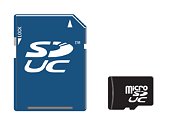
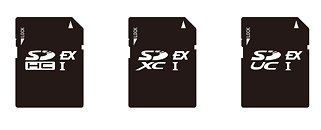
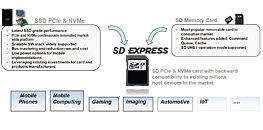
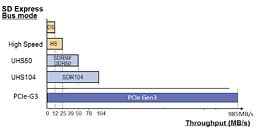
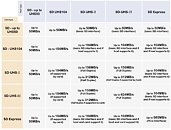
11 Comments on SD Express is a New Memory Card Standard That Leverages PCIe and NVMe
I'm sure consumers will know exactly what works with what after this clear and concise delivery by the SD Association...
Also giving sd cards full physical memory read access is a horrible horrible idea. Say hello to spy SD cards that can record audio, listen to keystrokes, record video output and with a convenient TB size buffer right there on the SD card.
Meaning if the new cameras will have a native SD Express slot, and if I insert an SD-UHS-III card with, let's say, 160MB/s transfer, it's going to be limited to 104MB/s ??
- IDontKnowWhatImDoing